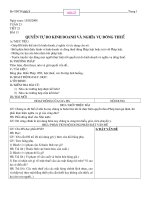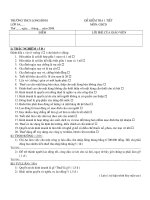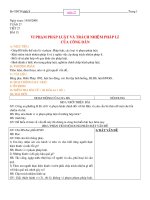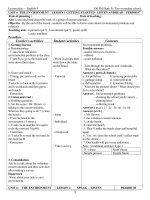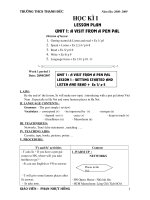giao an 9
Bạn đang xem bản rút gọn của tài liệu. Xem và tải ngay bản đầy đủ của tài liệu tại đây (209.74 KB, 20 trang )
<span class='text_page_counter'>(1)</span><div class='page_container' data-page=1>
<b>Week 1: Preparing date: August 9th<sub> , 2011</sub></b>
<b>Period 1: Teaching date: August 16th<sub> , 2011</sub></b>
<b>HOW TO LEARN ENGLISH EFFECTIVELY</b>
<b> * Aims: </b>
Ss can know how to learn English effectively.
<b> * Objective: </b>
- By the end of the lesson, ss will be able to know the purpose of learning English, how to
learn it, and read the alphabet in Engilsh.
<b>Timing</b> <b>Content</b> <b>T and Ss’ activities</b> <b>Rationale</b>
15’
15’
13’
<b>I./ The purpose of learing</b>
<b>English.</b>
- Phải học tiếng Anh bởi vì tiếng
Anh là một mơn học bắt buộc tại
các trường phổ thông. – Phải
biết tiếng Anh bởi vì nó là một
ngơn ngữ quốc tế và là chìa khóa
đến với kiến thức của nhân loại.
- Biết tiếng Anh giúp cho học
sinh có được nhiều cơ hội xin
việc làm, thăng tiến trong tương
lai. Hơn nữa, ngày nay tiếng Anh
được sử dụng trong nhiều lĩnh
vực khác nhau: Thương mại, văn
hóa, khoa học, kinh tế. II/.The
<b>way of learning English.</b>
- Vocabulary: Miệng đọc, tai
nghe, tay viết, mắt nhìn. Nhớ
chính tả, nghĩa, từ loại, phát âm,
và các âm tiết được nhấn. Học
các câu có từ mới.
- Sentence: Học thuộc các bài
hội thoại ngắn mà trong đó có
các mẫu câu. Luyện nói các mẫu
câu ở lớp với bạn, về nhà viết ra
vở nháp và sau đó so sánh với vở
ghi.
<b>III/. The Alphabet in English. (</b>
<b>26 letters ).</b>
a b c d e
f g
h i j k l
m n
p q r s t
u v
w x y z
- Ask ss to tell the purpose of
learning English.
- Comment on ss/<sub> idea and</sub>
provide some more purposes of
learning English.
- Get ss to tell their own ways
of learning English ( vocabulary
, sentences ... )
- Comment on ss/<sub> idea and</sub>
provide some more ways of
learning English.
- Ask ss how many letters there
are in Vietnamese alphabet.
- Tell ss the differences
between Vietnamese alphabet
and the English one.
- Guide ss to read letter by
`
- Help ss to
know the
importance of
learning
English.
- Guide ss
how to learn
the skills:
listening,
speaking,
reading,
writing.
</div>
<span class='text_page_counter'>(2)</span><div class='page_container' data-page=2>
2’
<b>* Homework:</b>
- Repare the new lesson: Unit 1
(A 1 - 4 P.10 – 11).
letter.
- Copy down.
way to read
letter by
letter.
* Help sts to
know what
they do and
what they
learn at
</div>
<span class='text_page_counter'>(3)</span><div class='page_container' data-page=3>
<b>Week 1: Preparing date: August 9th<sub> , 2011</sub></b>
<b>Period 2: Teaching date: August 16th<sub> , 2011</sub></b>
I. Aim: <b> Reading about the work of a group of conservationists and listening for details to</b>
<b>complete the notes .</b>
<b>II. Objective: </b>By the end of the lesson, students will be able to know more about the
environment problems and the solutions.ss can use conditional sentences.
<b>III. Language contents</b>:
<i><b>Vocabulary:</b></i>
<i><b>Grammar:</b></i> If _ Clause
<b>IV. Teaching aids: </b>Text book, pictures.
<b>V.Procedures:</b>
<b>TIME</b> <b>CONTENT</b> <b>ACTIVITIES</b> <b>RATIONALE</b>
<b>1’</b>
<b>5’ </b>
<b>7’</b>
<b>1. Class order:</b>
<b>2. WARM UP</b>
<b>Getting started: (Matching)</b>
a. air pollution
b. spraying pesticides
c. garbage dump
d. water pollution
e. deforestation
f. dynamite fishing
<b>3. New lesson:</b>
<b>PRESENTATION</b>
▪ <b>Vocabulary:</b>
+ garbage dump: đ ng raùc ố
+ sand ( n ) : cát
+ rock ( n ) : đá
+ shore ( n ) ; b bi nờ ể
+ disappointed (adj): th t v ng, bu n r uấ ọ ồ ầ
+ to provide : cung c p ấ
+ pollution ( n ) : s ô nhi m ự ễ
<b>What and where </b>
- Ask students to match
the words in the box with
the pictures on p.47
- correct
- Set the sence
- Teacher elicits
vocabulary with picture,
situation
-Teacher models.
-Students repeat in
chorally, and
individually.
-Teacher writes the word
on the board
-Teacher checks
students’ understanding
-check the stress
-Students copy down the
new words
-Teacher checks
students’ memories.
</div>
<span class='text_page_counter'>(4)</span><div class='page_container' data-page=4>
<b>5’</b>
<b>5’</b>
<b>5’</b>
<b> </b>
<b> Presentation text</b> 2 _ P.47
<b>a. Matching</b>
1. f 2. e 3. b
4. a 5. c 6. d
<b>b. Comprehension questions</b>
1. Mr Brown is the speaker.
2. The listeners are the volunteer
conservationists.
3. They are on the beach.
4. They are going to clean the beach.
5. If they work hard today, they will make
the beach clean and beautiful again soon.
<b> </b>
<b> Model sentences:</b>
If they work hard today, they will
make the beach clean and beautiful
again soon.
<b>If _clause</b> <b>Main clause</b>
Present Simple Future Simple
Present Simple
<i><b>If S + Vs(es) , S + will + Vo</b></i>
<i><b> Note</b></i>: <b>The conditional sentences</b>.
Câu điều kiện: có 2 mệnh đề, mệnh đề
chính (main clause) chỉ kết quả và mệnh đề
If chỉ điều kiện (If_ clause)
<b>PRACTICE: </b>
<b>Word Cue Drill:</b>
- Feedback
Set the scene: Mr
Brown is talking to some
volunteer
conservationists. They
are going to clean the
beach..
-Ask students to match
the names in column A
with the activities in
column B (exercise 2a
on p.48)
- Students work in pairs
to read the text again
then match
-Feedback
- Ask students to work in
pairs to answer the
questions on p.48
( exercise 2b)
- Call on some pairs of
students to ask and
answer the questions
- Feedback
-Teacher focuses the
model sentences
+What will they achieve
if they work hard today?
+Teacher checks the
meaning, the form, the
usage, and
pronunciation.
</div>
<span class='text_page_counter'>(5)</span><div class='page_container' data-page=5>
<b>9’</b>
<b>7’ </b>
<b>1’</b>
a. If / Lan / be / tired , she / stay / in bed
b. If / she / study hard , she / pass / the
exam
c. If / they / have / the time , they / visit /
their frends
d. If / he / get / one mark , he / be / sad
e. If / I / have / money , I / buy / a new
house
f. If / we / come / late , we / miss / bus
<b>FUTHER PRACTICE: </b>
<b> </b>
<b> Discussion</b>:
6. Have you ever done any thing similar ?
If yes , what did you do ? where did you do
it ?
<b>Possible:</b>
_ Yes, I have. We clean our school/ the
park/ street. We collected the rubbish and
take them to the garbage dump.
7. If the pollution continues , what might
happen ?
<b>Possible</b>:<b> </b>
-If the pollution continues, the environment
around us won’t be good and it will harmful
to our health and our life.
<b>4. HOMEWORK:</b>
<b>-</b> Learn all new words by heart.
- Practice new structure fluently.
-Teacher puts a poster
on the board.
-Teacher runs through
vocabulary.
-Teacher models
-Students repeat in
chorally, and
individually.
-Students make
sentences.
-Feedback
-Ask SS to discuss in
group of 4
- Call some groups to
talk their opinions
- correct
-Teacher gives some
instruction for
homework.
</div>
<span class='text_page_counter'>(6)</span><div class='page_container' data-page=6>
<i><b>Date of Preparing: January 7</b><b>th</b><b><sub> , 2011</sub></b></i>
<i><b>Date of Teaching: January 10</b><b>th</b><b><sub> , 2011 </sub></b></i>
<b>I. Aim: </b>Practice speaking to persuade people to protect the environment.
<b>II. Objective: </b>By the end of the lesson, students will be able to persuade their friends to protect
the environment.
<b>III</b>. <b>Language content</b>s:
<i><b>Vocabulary: </b></i>prevent, reduce, wrap, faucet, leaf- leaves
<i><b>Grammar:</b></i> Simple present tense.
<b>IV. Teaching aids: </b>Text book, posters, pictures.
<b>V</b>. <b>Procedures:</b>
<b>TIME</b> <b>CONTENT</b> <b>ACTIVITIES</b> <b>RATIONALE</b>
1’
5’
8’
<b>1. Class order:</b>
<b>2. WARM UP: (Jumbled words)</b>
1. uaderpse <sub></sub> persuade
2. beaargg <sub></sub> garbage
3. rodepvi <sub></sub> provide
4. lupotilon <sub></sub> pollution
5. duproce <sub></sub> produce
6. paispoidednt <sub></sub> disappointed
<b>3. New lesson:</b>
<b>PRE SPEAKING: </b>
<b>Vocabulary:</b>
+ prevent (v): ng n ch nă ặ
+ reduce (v): gi m, laøm gi mả ả
+ wrap: bao b cọ
+ faucet (n): voøi n c ướ
+ leaf <sub></sub>leaves: laù caây
<b>Slap the board</b>
- Students practice in
teams
- Students from two
teams come to the board
and write the correct
words
- Set the sence
-Teacher elicits
vocabulary with picture,
translation.
-Teacher models.
-Students repeat in
chorally, and
individually.
-Teacher writes the word
on the board
-Teacher checks
students’ understanding
-Students copy down the
new words
- Help Ss revise
old words
- Provide new
words and help
Ss understand the
content.
- Help Ss
remember the
new words.
<b>Duy t c a T Tr</b>
<b>ệ ủ</b>
<b>ổ</b>
<b>ưở</b>
<b>ng</b>
<b>Unit 6: THE ENVIRONMENT</b>
<b>Lesson 2: Speak P. ( 49 -50)</b>
</div>
<span class='text_page_counter'>(7)</span><div class='page_container' data-page=7>
6’
5’
13’
<b>Expressions</b>: <i>we use to express</i>
<i>persuasion</i>
I think you should
Won’t you
It would be better if you + V_infinitive
Can I persuade you
Why don’t you
Why not
What/ How about + V_ ing
◦ <b>Matching</b>: 3a_ P.49
<b>While speaking:</b>
<b> * Example</b>
I think you should use banana leaves
to wrap food.
Won’t you use banana leaves to
wrap food?
Why don’t you turn off the lights
before going to bed?
It would be better if you go to school
or go to work by bike.
Can I persuade you check all the
faucets before going out?
Why not put garbage bins around the
school yard?
I think you should use public buses
instead of motorbike.
What about using public buses
instead of motorbike?
◦ <b>Questionnaire:</b>
<i><b>Possible answers</b></i>
1. I think you should write on both sides of
the paper, recycle used paper, newspapers.
2. + How about cleaning and reusing them?
+ Why not use paper bags instead of
plastic bags?
3. Don’t through waste and garbage into
-Teacher checks
students’ memories.
-Teacher presents
expressions, and check
the usage
- Ask students to
complete the
expressions in column A
by using one of the lines
in column B on p.49
- Students do
individually then
compare with their
partners.
- Have students match
the lines in column B
with an expression in
column A so that they
have sentences of
persuasion
- Call students call out
their sentences untill all
sentences are finished.
- Check their
pronunciation
- Let students work in
pairs to answer the
questions in the
questionaire
- Feedback
- Ask students practice
asking and answering
the questions
- Help ss focus on
the content of the
text.
- Help Ss
understand the
content.
- Help Ss make
the dialogue
- Help Ss use the
new structure and
practice it
</div>
<span class='text_page_counter'>(8)</span><div class='page_container' data-page=8>
6’
1’
streams, lakes, rivers and even ocean.
4. I think we should put garbage bins around
the school yard.
5. + Can I persuade you go to school by
bike?
+ Why not use private vehicles less?
6. Try to use and recycle things.
<b>Post speaking </b><b> * Discussion</b>
<i><b>“ What do you do to protect the</b></i>
<i><b>environment”</b></i>
<b>4. Homework:</b>
write some ways to protect the environment
in their notebooks
- Students practice in
groups to discuss the
question: “What do you
do to protect the
environment?”
- Students in groups of
six. Each group has a
secretary write down the
opinions
-Teacher asks students
to use the ideal in 3a and
3b
- Feedback
-Teacher gives some
instruction for
homework.
-Students listen and take
note.
- Help Ss practice
speaking with
protection
invironment .
- Help Ss speak
about protection
invironment in
class, house and
country
</div>
<span class='text_page_counter'>(9)</span><div class='page_container' data-page=9>
<i><b>Date of Preparing: January 7</b><b>th</b><b><sub> , 2011</sub></b></i>
<i><b>Date of Teaching: January 13</b><b>th</b><b><sub> , 2011 </sub></b></i>
<b>I.</b> <b>Aims</b>: Listening fof details to complete the notes.
<b>II.</b> <b>Objectives</b>: By the end of the lesson , students will be able to know more about the
environment problems and how the environmennt is polluted.
<b>III.</b> <b>Language contents</b>:
Vocabulary: sewage, to spill, pump, drop
Grammar: Present Simple tense
<b>IV.</b> <b>Teaching aids</b>: Textbook, casset
<b>V.</b> <b>Procedures</b>:
<b>TIME</b> <b>CONTENT</b> <b>ACTIVITIES</b> <b>RATIONALE</b>
<b>1’</b>
<b>5’</b>
<b>7’</b>
<b>1. Class or</b>
<b>der:</b>
<b>2. Warm up: (</b>
<b>What And Where)</b><b>3. New lesson:</b>
<b>PRE LSITENING:</b>
<b>Vocabulary:</b>
- sewage (n): chất thải, nước cống
- (to) spill : làm tràn, đổ
- A dump : bãi đổ, nơi chứa
- (to) pump: thải ra
- (to) drop: quăng bỏ
◦
<b>R. O . R</b>
-Teacher writes each
word in a circle on the
board. Practice saying
the words, rubs out word
by eword.
-Teacher gets students
repeat the words
including the rubbed out
ones, students try to
remember all the words.
- Teacher elicits new
words, using pictures,
translation, and situation
- Teacher models.
- Students repeat.
- Teacher checks their
pronunciation.
- Teacher writes the
word on the board.
- Teacher checks their
understanding.
- Students copy down.
- Teacher checks
- Help Ss revise
old words.
- Provide new
words and help
Ss understand the
text.
- Help Ss
remember words
<b>Duy t c a T Tr</b>
<b>ệ ủ</b>
<b>ổ</b>
<b>ưở</b>
<b>ng</b>
<b>Unit 6: THE ENVIRONMENT</b>
<b>Lesson 3: Listen P. (50)</b>
</div>
<span class='text_page_counter'>(10)</span><div class='page_container' data-page=10>
<b>5’</b>
<b>18’</b>
<b>8’</b>
◦
<b>Gap fill</b> : A_ P. 50
<b>WHILE LISTENING: </b>
<i><b>Answer key:</b></i>
<b>Comprehension Questions: </b>
1. Where does the pollution of the oceans
come from?
2. How is garbage dropped into the sea?
How much?
3. What causes oil spills from ships?
4. How can waste materials from factories
run into the sea?
<i><b>Answer</b></i>
1. From the land, which means it comes
from people.
2. Ships (dropped garbage into the sea).
About 6 million tons each yaer.
3. Ships accidents.
4. Factory owners let the waste run directly
into the rivers, then run into the sea.
<b>POST LISTENING:</b>
<b>True / False repetition</b>
1. Our ocean are becoming extremely
polluted. (repeat)
students’ memories.
-Teacher puts a poster
with a table on the
board.
-Teacher asks students
to guess <i>How the ocean</i>
<i>is polluted</i> , then
complete the table.
-Students works in pairs.
-Feedback.
-Students listen to the
tape and check their
prediction.
-Teacher gives
feedback, and corrects
the mistakes.
-Teacher puts a poster
with 4 questions on the
board.
-Teacher asks students
to answer these
questions in groups of
four.
-Students works in
groups
-Feedback.
- Help Ss focus
on the text
- Help Ss listen to
take information.
- Help Ss exploit
the content of the
text
- Help Ss
<b>How the ocean is polluted</b>
Firstly: raw sewage is pumped directly
into the sea
Secondly:__________dropped into the
sea.
<b>How the ocean is polluted</b>
Firstly: raw sewage is pumped directly
into the sea
Secondly: garbage is dropped into the
sea.
</div>
<span class='text_page_counter'>(11)</span><div class='page_container' data-page=11>
<b>1’</b>
2. Most of this pollution come fro the
natural. (silent)
3. Oil spills come from land. (silent)
4. There are waste material come from
factory then leads to the sea. (repeat)
<b>Retell</b>:
<i><b>How the ocean is polluted</b></i>
<b>4. Homework:</b>
-Learn all new words
-Write a short passage “<i><b>How the ocean is</b></i>
<i><b>polluted</b></i>“
-Teacher reads the
sentences.
-Students listen and
repeat if it is true.
-Teacher asks students
to retell <i>How the ocean</i>
<i>is polluted.</i>
-Students work in groups
of four
-Teacher gives some
instruction for
homework.
-Students listen and
takenote.
understand the
content of the
text
- Help Ss retell
How the ocean is
polluted.
</div>
<span class='text_page_counter'>(12)</span><div class='page_container' data-page=12>
<i><b>Date of Preparing: January 15</b><b>th</b><b><sub> , 2011</sub></b></i>
<i><b>Date of Teaching: January 17</b><b>th</b><b><sub> , 2011 </sub></b></i>
<b>I. Aim: </b>Reading a poem about the environment
<b>II. Objective: </b>By the end of the lesson, students will be able to understand the poem about the
environment.
<b>III</b>. <b>Language contents</b>:
<i><b>Vocabulary: </b></i>junk yard, treasure, hedge, nonsense, foam,
Grammar: Simple present tense
<b>IV. Teaching aids: </b>Text book, posters, pictures
<b>V</b>. <b>Procedures:</b>
<b>TIME</b> <b>CONTENT</b> <b>ACTIVITIES</b> <b>RATIONALE</b>
<b>1’</b>
<b>5’</b>
<b>12’</b>
<b>1. Class order:</b>
<b>2. Warm up:</b>
<b> (</b>
Chatting)
Do you like poetry?
Which poet do you like best?
Name some poems that are your
favorite?
Do you think it is easy to understand
a poem/
Have you ever read an English
poem? Do you understand it?
Do you like it?
<b>3. New Lesson:</b>
<b>PRE READING</b> :
▪ <b>Vocabulary:</b>
+ junk yard: baõi ph th iế ả
+ treasure: kho báu
+ hedge: hàng rào
+ nonsense: đi u voâ ngh a, d i d tề ĩ ạ ộ
+ foam: b tọ
<b>What and where:</b>
-Teacher asks
-Students answer
-Teacher elicits
vocabulary with picture,
translation.
-Teacher models.
-Students repeat in
chorally, and
individually.
-Teacher writes the word
on the board
-Teacher checks
students’ understanding
-Students copy down the
new words
- Help Ss revise
old lesson
- Provide new
words and help
Ss understand the
content.
- Help Ss
remember words
<b>Duy t c a T Tr</b>
<b>ệ ủ</b>
<b>ổ</b>
<b>ưở</b>
<b>ng</b>
<b>Unit 6: THE ENVIRONMENT</b>
<b>Lesson 4: Read P. (50)</b>
</div>
<span class='text_page_counter'>(13)</span><div class='page_container' data-page=13>
<b>18’</b>
<b>Presentation poem</b>
<b>Pre questions</b>
+ Who are the people in the poem?
+ Where are they?
<b>WHILE READING:</b>
<b> Answers + </b>The mother and her son.
+ They are in the park/ woods.
<b>Matching</b>
1_c 2_g 3_f 4_e 5_d 6_a
7_b
Comprehension questions
<i><b>Lucky numbers!</b></i>
1 2 3 4 5 6 7 8
9
1. According to the mother, what will
happen if the pollution goes on?
If the pollution goes on, the word will
end up like a second hand junk yard.
2. Lucky number!
3. Who does the mother think pollute
the environment?
The mother thinks other folk pollute
(are responsible for the pollution of ) the
environment but not her and her son.
4. What will happen to the boy if he
keeps on asking his mother such
question?
-Teacher checks
students’ memories.
Set the scene: Two
people are going on the
picnic. They are talking
about the pollution.
- Give students two
questions
- Students in pairs
answer the question
before reading the poem
- Feedback
- Have students to read
the poem and check their
answers
- Ask students to practice
asking and answering
the questions in pairs
- Have students match
the words in column A to
an appropriate
explanation in column B
-Teacher asks students
to read the poem again
to answer the question
- Students answer the
questions from 1 to 5
- Students work in pairs
-Teacher writes 9
numbers with 4 lucky
numbers on the board.
-Students work in team.
One team start. They
choose one number, if it
is lucky number, they get
marks, needn’t answer
the question, if it is not
they must answer the
question to get marks.
- Help Ss focus
on the poem
- Help Ss
understand the
content of the
poem
</div>
<span class='text_page_counter'>(14)</span><div class='page_container' data-page=14>
<b>8’</b>
<b>1’</b>
If the boy keeps asking such questions,
his mother will take him home right
away.
5. Lucky number!
6. Do you think the boy’s question
(lines 9-10) is silly? Why (not)?
No. Because he is right. If he throws the
bottle
that will be polluting the woods.
7. Lucky number!
8. What does the poet want us to learn
about keeping the environment
unpolluted?
The poet wants us to learn that
everyone is responsible for keeping the
environment from pollution / stopping
pollution.
9. Lucky number!
<b>POST READING:</b>
▪ <b>Discussion</b>
<i>“What could you do in your school/ house to</i>
<i>minimize pollution?”</i>
<i><b>Possible answer</b></i>
Put the bins around the school yard
Pick up the rubbish/ garage and
throw it into the trash bin
Should not litter/ split on the ground…
<b>4.Homework:</b>
-Write 5 things that they have to do to keep
the environment unpolluted.
- Have students discuss
the question: “What
could you do in your
school/ house to
minimize pollution?”
- Students work in
groups
-Feedback
-Teacher gives some
instructionS for
homework.
-Students listen and take
note.
- Help Ss speak
the way to
minimize
pollution.
</div>
<span class='text_page_counter'>(15)</span><div class='page_container' data-page=15>
<i><b>Date of Preparing: January 13</b><b>th</b><b><sub> , 2011</sub></b></i>
<i><b>Date of Teaching: January 20</b><b>th</b><b><sub> , 2011 </sub></b></i>
<b>I. Aim</b>: Writing a letter of complaint.
<b>II. Objective</b>: By the end of the lesson, students will be able to write a complaint letter.
<b>III.Language contents:</b>
Vocabulary:
<i><b>Grammar:</b></i> Present simple tense
<b>IV. Teaching aids</b>: Text book, posters, pictures
<b>V. Procedure</b>
<b>TIME</b> <b>CONTENT</b> <b>ACTIVITIES</b> <b>RATIONALE</b>
<b>1’</b>
<b>5’</b>
<b>15’</b>
<b>1. Class order:</b>
<b>2. Warm up: (Categories)</b>
<b>T writes:</b> a b c d
Add borrow cut drive
<b>T writes:</b> s t u v
Study talk use value
<b>3. New lesson: </b>
<b>PRE - WRITING: </b>
◦ <b>Vocabulary:</b>
+ complain (v): than phi nề
+ complaint (n):
+ complication (n): đi u gây r c r iề ắ ố
+ resolution (n): trôi n i, b ng b nhổ ồ ề
+ prohibit (v): ng n c n, ng n c mă ả ă ắ
<b>R.O.R</b>
-Teacher asks students
to find out the verbs
beginning with the letter
that teacher gives.
-Teacher devides class
into 2 groups.
-Teacher gives 5 letters
at the same time;
students are to find out 5
verbs beginning with 5
letters given.
-The team which finish
first get marks.
-Teacher elicits
vocabulary with picture,
translation, and situation
-Teacher models.
-Students repeat in
chorally, and
individually.
-Teacher writes the word
on the board
-Teacher checks
students’ understanding
-Students copy down the
new words
-Teacher checks
- Help Ss revise
old lesson
- Provide new
words and help
Ss understand the
content.
- Help Ss
remember words
<b>Duy t c a T Tr</b>
<b>ệ ủ</b>
<b>ổ</b>
<b>ưở</b>
<b>ng</b>
<b>Unit 6: THE ENVIRONMENT</b>
<b>Lesson 5: Write P. (50)</b>
</div>
<span class='text_page_counter'>(16)</span><div class='page_container' data-page=16>
<b>18’</b>
<b>Presentation “ A complaint letter”</b>
<b>ORDERINGTHELETTER :</b>
a. Action: talk about future action
b. Situation: states the reason for
writing
c. Politeness: ends the letter politely
d. Complication: mention the problem
e. Resolution: makes a suggestion
<b> A</b><i><b>NSWERS</b></i>
<b>1 _ b 2 _ d 3 _ e 4 _ a 5 _ c</b>
<b>Matching</b><b> Answers</b>
R: I would guggest……….bnefore leaving.
S: I am writing………to the north.
A: I look forward………..your company.
C: When the truck………..and flies.
P: Sincerely
Tran Vu Nhat
<b>WHILE – WRITING: </b>
<b>Questions</b><b>a.</b> What do people do behind your
house these days?
_ They begin to catch fish.
<b>b.</b> What makes you worried?
_ they use electricity to catch fish.
<b>c.</b> To whom do you write the letter to?
_ We write to the head of the local
authorities.
<b>d.</b> What suggestion do you want to
make?
_ We suggest thelocal; authorities
should prohibit and fine heavily.
<b>e.</b> Any future plan you want to make?
- We look forward to seeing the
protection of environment from the local
authorities.
<b>Suggested letter</b><i>Dear Mr president</i>
<i>I am writing to you about the problem of fish</i>
<i>catching in the lake behind my house.</i>
<i>I am very worried because people use</i>
students’ memories.
- Provide students five
sections of a complaint
letter with their
definitions in random
letter
- Get them to put the
sections in the correct
order
- Feedback
<b>Set the scene:</b> Mr Nhat
write a letter to the
director of L& P
Company in HCM city
- Ask students read the
letter on p. 52
+ Who wrote the
letter?
+ Whom did he write
to?
- Ask students to label
each section with the
appropriate letter: S, C,
R, A or P
- Students work in pairs
- Feedback
- let students read the
production 6b on p.53
- Write some questions
on the board
- Ask students to answer
the questions
- Help Ss order
the letter
</div>
<span class='text_page_counter'>(17)</span><div class='page_container' data-page=17>
<b>5’</b>
<b>1’</b>
<i>electricity to catch fish. After a short time</i>
<i>they left the lake, a lot of small fish died and</i>
<i>floated on the water surface. Other animals</i>
<i>such as frogs, toads, and even birds also</i>
<i>died from electric shock waves.</i>
<i>I could suggest the local authorrities should</i>
<i>prohibit and find heavily anuone using this</i>
<i>way of catching fish.</i>
<i>I look forward to hearing from you and</i>
<i>seeing the protection of environment from</i>
<i>the local authority.</i>
<i>Sincerely, </i>
<b>POST- WRITING </b>
<b>Correction</b><b>4. Homework:</b>
<b>-</b>Learn all new words
-Write their letter in their notebooks
- Ask students to write
the letter individually
- Students share with
their partners
- Move around the class
and help students
- Call on some students
to read their letter
- Give feedback and
correct some letter
before the class.
-Teacher gives some
instruction for
homework.
-Students listen and
takenote.
- Help Ss correct
the letter
</div>
<span class='text_page_counter'>(18)</span><div class='page_container' data-page=18>
<i><b>Date of Preparing: January 22</b><b>nd</b><b><sub> , 2011</sub></b></i>
<i><b>Date of Teaching: January 24</b><b>th</b><b><sub> , 2011 </sub></b></i>
<b>I.</b> <b>Aim:</b> Revision of some adjectives and adverbs and Adjective + That Clause
<b>II.</b> <b>Objective: </b>By the end of the lesson, students will be able to use adjective and adverb
to make sentences with adjective + that clause
<b>III.</b> <b>Language contents: </b>
<i><b>Vocabulary:</b></i>
<i><b>Grammar:</b></i>
<b>IV.</b> <b>Teaching aids:</b> text book, pictures
<b>V.</b> <b>Procedures:</b>
<b>TIME</b> <b>CONTENT</b> <b>ACTIVITIES</b> <b>RATIONALE</b>
<b>1’</b>
<b>5’</b>
<b>8’</b>
<b>1. Class </b>
<b>order:</b>
<b>2. Warm up:</b>
<b> (Pelmanism)</b>Extreme happy sad good slow
sadly
Fast slowly well fastly extremely
happily
<b>3. New lesson:</b>
<b>ADJECTIVE AND ADVERBS</b>
<b>Form</b> <b>Adj + ly = Adverb of manner</b>
Position Adjective can come in two places in a
sentence.
Before a noun.
After the verb “be, look, appear,
seem, feel, taste, sound, smell…….”
Adverb normally go after the direct object.
If there is no direct object, the adverb goes
after the verb.
I read the letter carefully.
She walked slowly.
◦ <b>Language Focus 1</b> _ P. 53
<i><b>Answers: </b></i>
a. Extremely c. sadly e. well
- Review old lesson how
to make adverbs of
manner and the position
- Ask students to use
adverbs provided in
“Pelmanism game” to
complete the sentences
on Language Focus 1 on
p. 53
- Students work in pairs
- Give feedback
- Give a situation
+ Why is Ba tired?
- Give students other
word for “because”
- Help Ss revise
ADVERBS AND
ADJECTIVES
- Help Ss use
model and do
exercise
- Help Ss use
adjective and
<b>Duy t c a T Tr</b>
<b>ệ ủ</b>
<b>ổ</b>
<b>ưở</b>
<b>ng</b>
<b>Unit 6: THE ENVIRONMENT</b>
<b>Lesson 6: Language Focus P. (53-56)</b>
</div>
<span class='text_page_counter'>(19)</span><div class='page_container' data-page=19>
<b>10’</b>
<b>10’</b>
b. Slowly d. happily
<b>ADVERB CLAUSES OF REASON</b>
<i><b>Eg: </b></i>
Ba is tired because / as / since he
stayed up late watching TV.
<i><b>Form</b></i>: <b>S + V + because / as / since + S +</b>
<b>V</b>
<b>Language Focus 2</b>_(P. 54,55)
<i><b>Answers</b></i>
a. I’m tired because/ since/ as I stay up
late watching TV.
b. I have a broken leg because I fell
over while I was playing basketball.
c. I’m going to be late for school
because the bus is late.
d. I broke the cup because I was
careless.
e. I want to go home because I feel
sick.
f. I’m hungry because I haven’t eaten
all day
<b>ADJECTIVE + THAT_ CLAUSE</b>
▪ <b>Dialogue</b>
Ba: Dad! I got mark 9 on my test!
Mr. Ha: That’s wonderful. I’m pleased
that you are working hard.
<i><b>Form:</b></i><b>S + be + Adj + that clause</b>
“<b>That clause</b>” dùng bổ sung nghĩa cho tính
từ
<b>Language focus 3 _ P.55</b>
<i><b>Answers</b></i>
a. That’s wonderful. I’m please that you are
working hard.
b. Tomorrow. I’m excited that you will go to
Da Lat this time.
c. I’m sorry that I broke your bicycle this
afternoon.
- Have students do the
Language Focus 2 on p.
54,55
- Students in pairs to join
the pairs of sentences
together using “because,
Since, As”
- Feedback
<b>Set the scene:</b> Ba is
talking to his father
about his test.
- Ask students to look at
the conversation
between Ba and his
father then set the scene
+ What did Ba say to
his father?
_ He said he got mark 9
on his test.
+ What did his father
say?
_ His father said
“That’s wonderful. I’m
pleased you are working
hard.”
- Give them the form.
<b>- </b>Ask students to do the
exercise in Language
Focus 3 on p. 55
- let students work in
pairs to complete the
dialogues
- Give feedback
adverbs fluently
- Help Ss revise
model, and do
exercises.
</div>
<span class='text_page_counter'>(20)</span><div class='page_container' data-page=20>
<b>10’</b>
<b>1’</b>
d. I’m disappointed that you didn’t phone
me about that.
e. Thanks. I’m amazed that I could win the
first prize.
<b>CONDITIONAL SENTENCES(</b>Type
1)
◦ <i><b>F</b><b>ORM</b></i><b> : </b>
<b> IFCLAUSE (V-SIMPLEPRESENT) ,S + V_(WILL + V)</b>
Main clause: Simple future tense
If clause: Simple present tense
◦ <b>Language Focus 4</b> _ P. 56
<b>Matching </b>(with answer key)
<b>1.</b> e
<b>2.</b> a
<b>3.</b> c
<b>4.</b> d
<b>5.</b> b
<b>4. Homework:</b>
-Write 5 sentences using the structure “Adj
+ that clause”
-Teacher reviews
conditional sentences
again.
- Have students do the
Language Focus 4 on p.
56
- Students work in pairs
and find out five
complete conditional
sentences
- Feedback
-Teacher gives some
instruction for
homework.
-Students listen and take
note.
- Help Ss use the
conditional
sentence type 1
- Help Ss
remember the
homework.
</div>
<!--links-->

